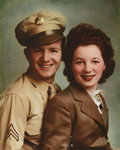
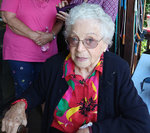
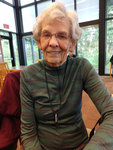
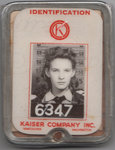
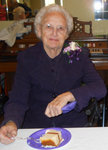

A 93-year-old Tenino woman from New York who tested airplane parts in what was called “the Gunk” will grace what may be the final Washington Women in Trades calendar featuring Rosie the Riveters.
Sally Sweeney, a prolific writer and artist, was 16 in 1942 when she began working at the Rome Army Air Force Command in New York, known today as Griffiss Air Force Base. She worked as a supervisor in the Mimeo, Ditto, and Embossograph Department, teaching incoming soldiers in the headquarters building.
While there, she met Corporal John “Jack” Sweeney of Plymouth, Pennsylvania, who was assigned to sort and deliver mail at the base. They married June 23, 1944, the same month she transferred to “the Gunk,” working in an aircraft hangar testing airplane parts for cracks and wiring airplane manifolds. By November she was pregnant, and she took maternity leave in March because she didn’t want the disagreeable fumes or other toxins to damage her baby.
Then, from 1949 to 1980, she and her husband and their son lived out of a trailer moving from one job to the next as Jack worked as a “tunnel stiff,” a worker who builds dams and digs tunnels. They retired to Tenino.
I met Sally nearly a decade ago when she published her first memoir, “Hayseed.” I have since helped her publish four more books.
Another book client introduced me to a Rosie who worked in the Kaiser Shipyards along the Columbia River in Vancouver. As Betty (Walla) Bolt shared her stories, it reminded me of yet another client, Loretta Downey of Chehalis, who was a 2014 calendar girl.
Betty, who lives in Portland, moved from North Dakota with her parents and two younger brothers after graduating from high school at 16 in 1942. They lost the farm her grandparents homesteaded near Arnegard after devastation by grasshoppers, rain, wind and dust.
“We packed up and came out here because there weren’t any jobs back there,” said Betty, 94. “No electricity. No plumbing. No nothing out there.”
The Walla family initially lived in Camas with a relative. Betty and her parents soon found jobs at the Kaiser Shipyards, which opened in early 1942 and drew nearly 40,000 people to Vancouver during World War II to build two dry docks and more than 140 aircraft carriers and cargo vessels.
Betty’s father, Clarence, worked inside the ships’ hulls while her mother, Cornelia, was a pipefitter. They hired Betty as a messenger, eight hours a day for 25 to 30 cents an hour. If someone in the pipe shop wanted steel, they’d call and Betty rode a bicycle to deliver the handwritten orders.
“I rode a bike up and down the shipyards,” she recalled. She later worked in the office.
“I hated my life at that time,” she said. “I left all my friends back home and came out here. At first the only people that worked here were old men. There weren’t any young people. All the young men were in the war.”
Like others, Betty knew people who died in the war — a teacher, a cousin and a man she dated.
Her family moved into one of the 5,500 prefabricated temporary homes for Kaiser workers, erected by the Vancouver Housing Authority in the McLoughlin Heights area.
“I know my mother was tickled to death when we got that cheap little home,” Betty recalled, noting it had three bedrooms, a bathroom with indoor plumbing, a coal-burning cook stove, and a refrigerator. Her brothers attended school while she and her parents worked.
On April 5, 1943, First Lady Eleanor Roosevelt and Henry Kaiser, company founder, spoke at the Kaiser Shipyards in Vancouver during the launching ceremonies of the USS Alazon Bay.
“Everybody got the day off and had the time to go watch,” Betty said.
She pulled out photos, ration cards and coupons, certificates, badges and even two metal bracelets her mother crafted during a slow time in the pipefitting shop. She even kept an uncashed check from Kaiser Company for 31 cents.
After leaving Kaiser in 1946, Betty worked for a telephone company and later a credit bureau in Portland before she married Roy Bolt and quit to stay home with her twins, a son and a daughter. She has two grandsons. She plays golf twice a week.
Betty’s recollections reminded me of Loretta’s book, which I helped her publish in 2008. Her son, William, gave me permission to share her story here.
Loretta Van Kleek, one of 12 children, lived in Mission, South Dakota, on the Rosebud Indian Reservation during the Dust Bowl years. The family first lived in a three-room sod house with a dirt floor before moving to a house outside of town. She recalled dirt blowing through cracks in their wood house and picking potato bugs off the garden plants. The family packed up all its belongings and moved west to Washington in the fall of 1937 and settled first near Adna and then on Prindle Street in Chehalis.
During World War II, Loretta’s father, Fred Van Kleek, started working for the Boeing Company in Seattle in 1942 and later at the branch plant in Chehalis from May 1943 until the war ended in August 1945.
Loretta’s sister, Lulu, had married Harry Hilts in 1943 and moved to Vancouver, where Harry worked in the Kaiser Shipyards. After she graduated from Chehalis High School that spring, Loretta and another sister, Betty, moved to Vancouver to live with Lulu and work in the shipyards.
“I was among 10,000 women working there,” Loretta said. “I don’t remember how much we were paid, but the wages were good at that time. I worked as a welder’s helper.”
Betty and Lulu both worked as pipefitters’ helpers. Harry was a welder.
“The work was all right but kind of scary at times,” she said. “We had to climb up and down many steps on the ships. Sometimes we had to climb down pretty low. We had to walk on the gangplanks, too. That in itself was scary!”
Loretta left the shipyards with a permanent reminder of her work as a Rosie.
“I lost part of my finger, the middle finger on my left hand,” she said. “I put my hand down in front of the motor when I went to shut off the welding machine, and I didn’t pay enough attention, I guess. It cut two of my fingers, clipping the top of the middle finger right off and injuring part of the next finger, too.”
A supervisor called an ambulance, which rushed her to the hospital. They did a skin graft on the injured finger but the other was cut close to the nerve.
“I wasn’t very happy about losing my finger,” Loretta said. “At first it bothered me a lot. It stayed sore for a long time, and I’d go to reach for something and I couldn’t grasp it because part of my finger was missing. People would ask about it, but I don’t remember being embarrassed about it in later years. I’m used to living without it now.”
She returned to work at the shipyards but quit after suffering appendicitis. Loretta later married Hayden Downey. Her sisters worked at Kaiser until the war ended.
We owe these women a lot for breaking the glass ceiling and showing the world that women can do jobs previously held only by men. It’s sad to say goodbye to so many of our Rosies, but I’m blessed to have had a small part in honoring them.
•••
Julie McDonald, a personal historian from Toledo, may be reached at memoirs@chaptersoflife.com.